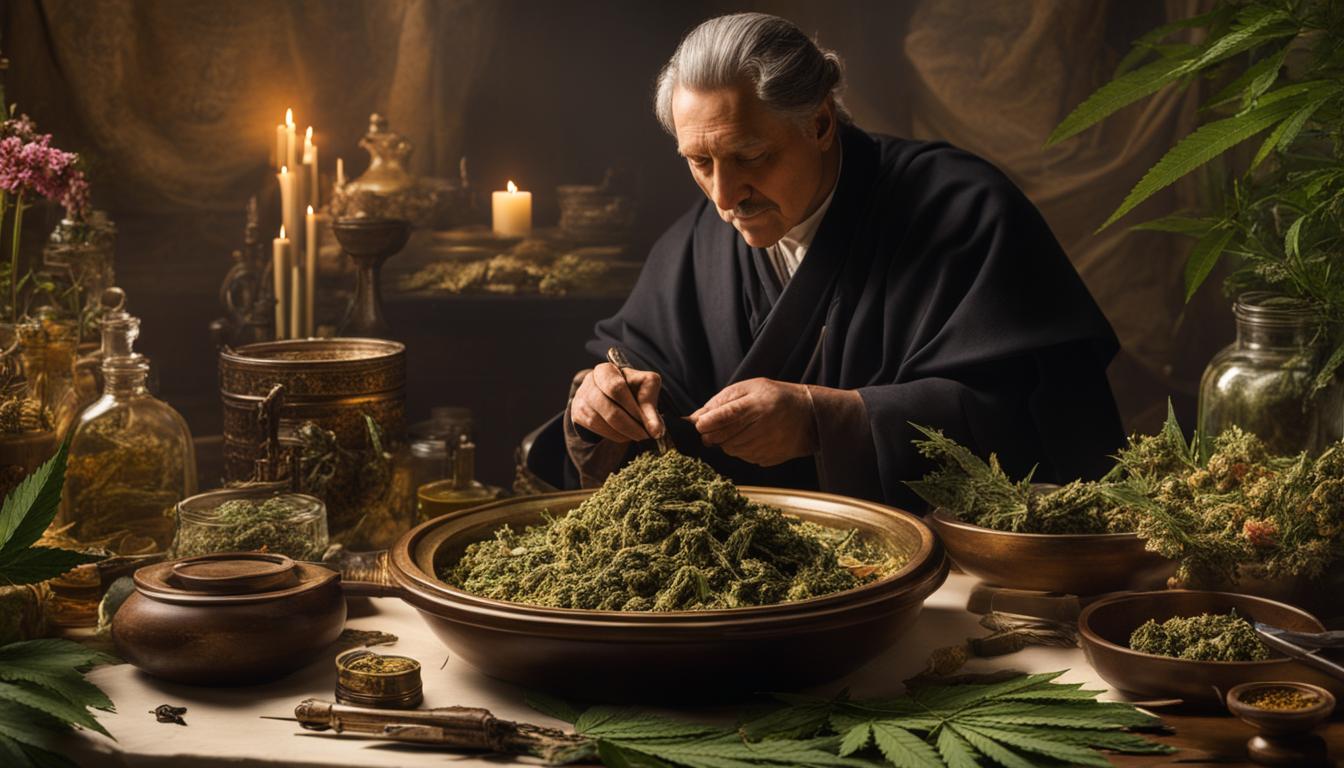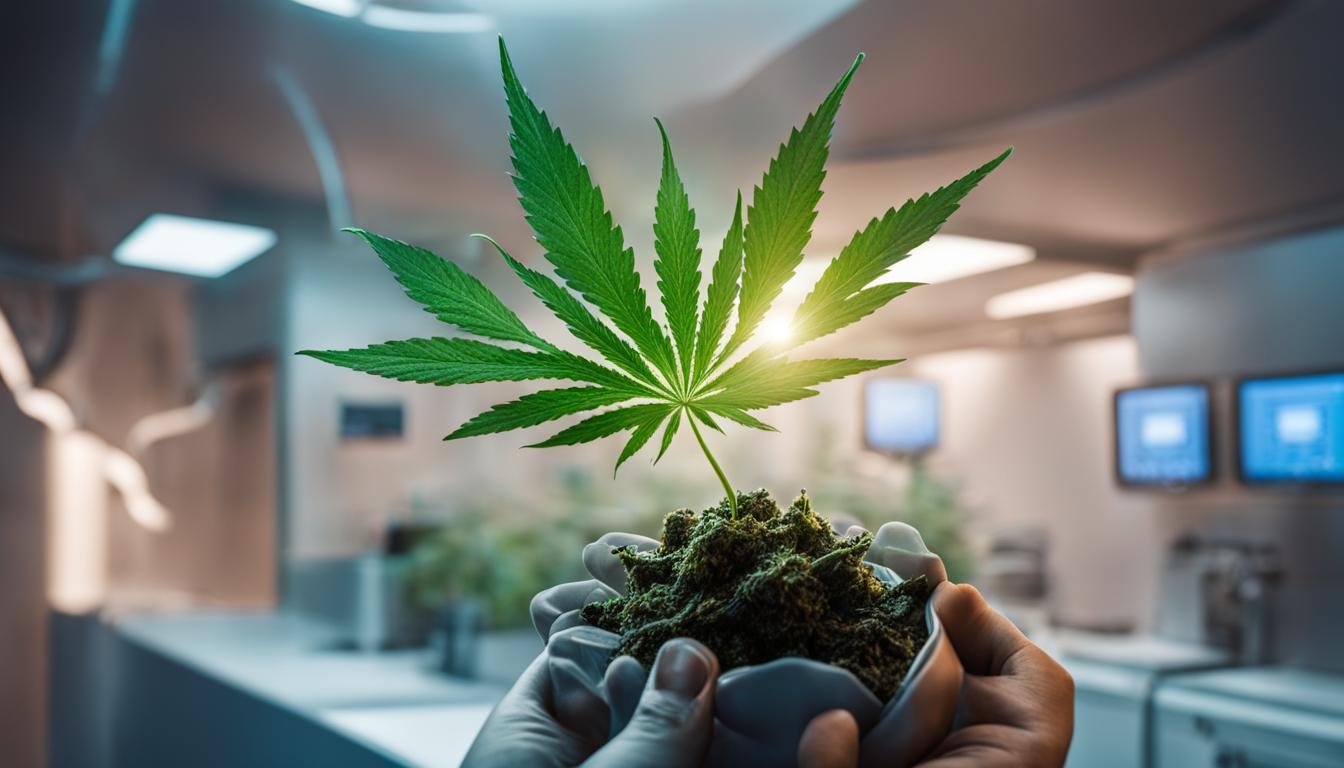What Were the Medicinal Uses of Cannabis in Ancient Rome?
Discover the fascinating history of cannabis in ancient Rome and its remarkable medicinal uses in ancient Roman medicine. Dive into the rich cultural practices and beliefs surrounding this powerful plant that played a significant role in ancient Roman society.
Step back in time and explore how cannabis and opium were used as medications in ancient Rome to treat a variety of conditions. Roman doctors recognized the potential healing properties of cannabis and documented its effects on the body, noting both its benefits and risks.
Ancient Roman authors and philosophers, such as Pliny and Seneca, delved into the medicinal uses of cannabis and its impact on society. Discover their insights and the wisdom they imparted on the significance of cannabis in ancient Roman literature and philosophy.
Uncover the ancient Roman medical practices involving cannabis, as documented by influential doctors like Dioscorides and Galen. Explore the various remedies and preparations that incorporated cannabis, from treating diarrhea in farm animals to alleviating pain, gout, and earaches.
Furthermore, delve into the role of cannabis in ancient Roman religion and recreation. Learn about its use in religious ceremonies and rituals, as well as its presence in social gatherings and intoxicating substances.
As we explore the history of cannabis in ancient Rome, we gain valuable insights into the development of ancient medicine and the cultural practices that shaped this fascinating era.
Ancient Roman Medical Practices Involving Cannabis
In ancient Rome, cannabis was a significant element in medical practices, with doctors incorporating it into various remedies and treatments. Prominent physicians like Dioscorides and Galen mentioned cannabis in their medical writings, shedding light on its potential uses and effects on the body. Cannabis was believed to have both positive and negative impacts, with ancient Roman doctors attributing it to a range of qualities and applications.
Ancient Roman Beliefs and Remedies
According to ancient Roman medical beliefs, cannabis had diverse purposes and effects. It was believed that cannabis could be used to create strong ropes and repel mosquitos. Additionally, cannabis had the reputation of decreasing sexual activity, causing impotence, and inducing nausea. It was served in small cakes for dessert and was thought to have a drying effect on the body. Cannabis was employed to treat various conditions such as diarrhea in farm animals, gout, arthritis, and earaches. Its usage spanned a wide range of ailments.
The Role of Cannabis in Ancient Roman Medicine
Ancient Roman doctors and their patients utilized cannabis in different forms for medicinal purposes. It was prescribed in recipes and preparations, often combined with other ingredients, to create treatments catering to specific needs. The healing properties associated with cannabis were extensive, as it was employed to alleviate pain, coughs, and hysteria. Notably, cannabis was also believed to treat gonorrhea, highlighting its varied applications in ancient Roman medicine.
Understanding Ancient Roman Medical Practices
Studying cannabis in the context of ancient Roman medical practices provides valuable insights into the historical development of medicine and the cultural beliefs surrounding healing. While ancient Roman society recognized the potential benefits of cannabis, it also acknowledged its addictive nature and potential risks. The utilization of cannabis in ancient Roman medicine reflects the fascinating intersection of medicinal knowledge and cultural practices in the ancient world.
| Ancient Roman Medical Practices Involving Cannabis |
|---|
| Ancient Roman Beliefs and Remedies |
| The Role of Cannabis in Ancient Roman Medicine |
| Understanding Ancient Roman Medical Practices |
Cannabis and Healing in Ancient Rome
In ancient Rome, cannabis was believed to possess various healing properties and was utilized in medical treatments. Physicians and writers of the time documented its potential effects on the body and its use as a remedy for different ailments.
Oribasius, the physician of Emperor Julian, observed that cannabis had the potential to harm the head while inducing a warm sensation. Marcellus Empiricus noted that when cannabis was wrapped around the arm and suspended from the neck, it could halt blood flow. It was also believed to be effective in treating gonorrhea, pain, coughs, and hysteria.
These ancient Roman medical professionals recognized the therapeutic value of cannabis and incorporated it into their healing practices. Its use in treating a range of physical and mental health conditions demonstrates the significance of cannabis in ancient Roman medicine.

Furthermore, cannabis products were prepared and used in various forms to administer treatment. Whether consumed orally or applied externally, cannabis was deemed beneficial in specific remedies. The utilization of cannabis-based treatments showcases the development of pharmacology in ancient Rome and the advancement of medical knowledge during that time.
Overall, cannabis played a significant role in the healing practices of ancient Rome. Its medicinal properties, as recognized by physicians and writers of the era, highlight the importance of cannabis in ancient Roman medicine and provide valuable insights into the historical development of medical practices.
Cannabis in Ancient Roman Literature and Philosophy
Ancient Roman literature and philosophy provide valuable insights into the historical context and perceptions surrounding the use of cannabis as medicine. Authors such as Pliny and Seneca dedicated sections of their works to discussing the effects and potential risks of cannabis. Pliny, in particular, highlighted the negative consequences of excessive drinking and the potential decrease in sexual potency associated with cannabis use.
Pliny’s observations on cannabis and its effects on the body emphasized the need for moderation and caution when using medicinal substances. He recognized the potential benefits of cannabis in treating certain ailments but also acknowledged the addictive nature and potential risks of excessive consumption. Seneca, on the other hand, focused on the broader issue of excessive alcohol consumption and the amplification of negative personality traits.
Pliny wrote, “In general, the immoderate use of wine and other pleasures is the revealing of, and the increase in, defects of character.”
While ancient Roman authors recognized the potential medicinal uses of cannabis, they also understood the importance of responsible usage and the potential dangers associated with its excessive consumption.
The Wisdom of Ancient Philosophers
Ancient Roman philosophers like Seneca believed in the importance of moderation and self-control. They saw the potential risks and negative consequences of substance abuse, including the excessive use of cannabis. Seneca warned against indulgence in intoxicating substances, emphasizing the need for individuals to maintain a balanced state of mind and avoid excesses.
By discussing the effects of cannabis and highlighting its potential risks, ancient Roman authors and philosophers highlighted the need for responsible and informed usage of medicinal substances. Their insights into the cultural and medical practices of ancient Rome offer valuable lessons for modern society.
Opium and Cannabis in Ancient Roman Medicine
In ancient Roman medicine, both opium and cannabis played significant roles as medicinal substances. The Romans were aware of the potential benefits and risks associated with these drugs, and they used them to treat various conditions.
“The use of opium and cannabis in ancient Roman medicine reflects the complex relationship between ancient societies and mind-altering substances.”
Opium, derived from the poppy plant, was known for its powerful pain-relieving properties. Ancient Roman doctors such as Dioscorides believed that opium could be used to treat insomnia, pain, coughs, hysteria, and digestive system issues. Despite recognizing its benefits, the Romans were cautious about its addictive nature and the potential dangers of excessive use.
| Opium in Ancient Rome | |
|---|---|
| Conditions treated | Insomnia, pain, coughs, hysteria, digestive system issues |
| Known risks | Addictive nature, potential dangers when used excessively |
Cannabis, on the other hand, was believed to have various medicinal properties in ancient Rome. It was used to treat conditions such as gout, arthritis, earaches, and even diarrhea in farm animals. However, like opium, cannabis was known to be addictive, and the Romans were aware of its potential risks.
| Cannabis in Ancient Roman Medicine | |
|---|---|
| Conditions treated | Gout, arthritis, earaches, diarrhea in farm animals |
| Known risks | Addictive nature |
The use of opium and cannabis in ancient Roman medicine provides insight into the medical practices and beliefs of the time. It showcases the ancient Romans’ understanding of the therapeutic benefits of these substances while acknowledging the risks associated with their usage.
Ancient Greek and Roman Medicine: The Medicinal Uses of Cannabis
The use of cannabis in ancient Greek and Roman medicine dates back to ancient times. Doctors and physicians of that era recognized the potential benefits of cannabis in treating various ailments. Cannabis, known as κάνναβις (kannabis) in ancient Greek, was highly regarded for its medicinal properties.
Ancient Greek and Roman medical literature, including the works of doctors like Dioscorides and Galen, documented the effects of cannabis on the human body. It was believed that cannabis could decrease sexual activity, induce a warm feeling, and even cause nausea. These properties made cannabis a valuable resource in ancient medicine.
“Cannabis possesses qualities that can decrease sexual activity and induce a warm feeling,” wrote Dioscorides, an ancient Greek physician.
In ancient Greek and Roman medicine, cannabis was often used in recipes and preparations, often mixed with other ingredients, to create medicinal treatments. The combination of cannabis with other herbs and substances was believed to enhance its healing properties.
Overall, the use of cannabis in ancient Greek and Roman medicine provides valuable insight into the historical roots of medicinal practices. It demonstrates how cannabis was seen as a powerful tool in the treatment of various ailments, and its use was a vital part of the medical landscape of that era.
https://www.youtube.com/watch?v=Me_gcsjbztU
Ancient Greek and Roman Medicine: Cannabis Use in Practice
In ancient Greek and Roman medicine, cannabis was utilized in various ways. Here are some examples:
- As a treatment for pain and inflammation
- To alleviate coughs and respiratory issues
- As a remedy for digestive system problems
- For easing symptoms of hysteria
- As a topical application for skin conditions
These applications demonstrate the versatility of cannabis in ancient medicine and highlight its potential as a natural remedy for a wide range of ailments.
Ancient Greek and Roman Medicine: The Legacy of Medicinal Cannabis
The use of cannabis in ancient Greek and Roman medicine has left a lasting legacy. While modern medicine has evolved and developed new treatments, the historical evidence of cannabis as a medicinal tool serves as a reminder of the valuable insights and practices of ancient civilizations.
Today, as the world re-discovers the potential health benefits of cannabis, it is important to recognize the wisdom of our ancestors and their understanding of its healing properties. Ancient Greek and Roman medicine provide a fascinating glimpse into the ancient roots of cannabis as medicine, further solidifying its place in history.
Cannabis in Ancient Roman Religion and Recreation
Cannabis played a significant role in ancient Roman society not only in medicine but also in religious and recreational contexts. The use of cannabis in religious ceremonies and rituals was believed to induce mystical or euphoric experiences, enhancing the spiritual connection between individuals and their gods. The ancient Roman literature mentions the presence of cannabis in different contexts, such as the serving of cannabis-infused desserts during social gatherings, further highlighting its recreational use.
While cannabis was enjoyed for its recreational effects, it is important to note that its use was not without risks and potential negative consequences. Ancient Romans were aware of the addictive nature of cannabis and the potential harm it could cause when used irresponsibly. This recognition of the potential dangers associated with cannabis demonstrates the understanding of the ancient Romans regarding the importance of moderation when indulging in recreational activities.
“Cannabis-infused desserts were a common feature at social gatherings, offering participants a pleasurable and relaxing experience.”
Ancient Roman Cannabis and Religion
In the realm of religion, cannabis was not only consumed but also utilized in rituals and ceremonies. The heightened states of consciousness induced by cannabis were believed to facilitate a deeper connection with the divine, allowing individuals to tap into spiritual realms and experiences. The inclusion of cannabis in ancient Roman religious practices underscores the significance of this plant in their belief systems and the role it played in their quest for spiritual enlightenment.
Ancient Roman Cannabis and Recreation
The recreational use of cannabis in ancient Rome served as a means of relaxation and enjoyment. Cannabis-infused desserts were a common feature at social gatherings, offering participants a pleasurable and relaxing experience. However, it is important to note that the ancient Romans recognized the potential risks associated with excessive cannabis consumption, highlighting the need for responsible and moderate indulgence. The recreational use of cannabis in ancient Rome provides us with a glimpse into the leisure activities and cultural practices of this fascinating period in history.
Overall, the role of cannabis in ancient Roman religion and recreation reflects the multifaceted nature of this plant in their society. From its potential to induce mystical experiences in religious rituals to its use as a recreational substance, cannabis held a significant place in the hearts and minds of the ancient Romans. Understanding their relationship with cannabis not only provides insights into their cultural practices but also offers a unique perspective on the historical use of this ancient plant.
| Table: Ancient Roman Cannabis in Religion and Recreation |
|---|
| The religious use of cannabis |
| The recreational use of cannabis |
| The potential risks and need for moderation |
Conclusion
Cannabis had a profound impact on ancient Roman medicine, playing a crucial role in the treatment of various ailments. The medicinal uses of cannabis in ancient Rome were well-documented by prominent physicians and philosophers, such as Dioscorides and Pliny. The history of cannabis in ancient Rome provides us with valuable insights into the medical practices and cultural beliefs of that time.
Ancient Roman doctors recognized the potential healing properties of cannabis, but they also acknowledged its addictive nature and potential risks. They used cannabis to treat conditions ranging from insomnia and pain to digestive issues and hysteria. Cannabis was incorporated into recipes and preparations, often combined with other ingredients to create medicinal treatments.
Furthermore, cannabis was not only limited to medical use but also found its place in ancient Roman religion and recreation. It was believed to have been used in religious ceremonies, possibly for its ability to induce mystical or euphoric experiences. Additionally, cannabis was enjoyed recreationally at social gatherings, where it served as an intoxicating substance.
Overall, the ancient Roman use of cannabis sheds light on the intersection of medicine, culture, and spirituality in ancient times. The history of cannabis in ancient Rome underscores the importance of understanding the cultural and historical context when examining the role of substances in medical practices. By exploring the ancient use of cannabis, we gain a deeper appreciation for the evolution of medicine and the enduring relationship between humanity and medicinal plants.
FAQ
What were the medicinal uses of cannabis in ancient Rome?
Cannabis was used in ancient Rome to treat conditions like insomnia and earaches. Roman doctors noted its addictiveness and believed it induced a warm feeling.
How did ancient Roman doctors use cannabis in their medical practices?
Ancient Roman doctors believed cannabis could be used to create strong ropes, repel mosquitos, decrease sexual activity, cause impotence, induce nausea, and treat diarrhea in farm animals, gout, arthritis, and earaches.
What effects did cannabis have on the body according to ancient Roman doctors?
Ancient Roman doctors believed cannabis could create a warm feeling, harm the head, stop blood flow when wrapped around the arm and suspended from the neck, treat gonorrhea, and be used as a treatment for pain, coughs, and hysteria.
Did ancient Roman authors and philosophers write about the effects and risks of cannabis?
Yes, authors like Pliny and Seneca wrote about cannabis, highlighting its potential dangers such as alcoholism, decreased sexual potency, and personality defects caused by excessive consumption.
How was opium used in ancient Rome?
Opium was commonly used in ancient Rome to treat conditions like insomnia, pain, coughs, hysteria, and digestive system issues, but it was known to be addictive and could have dangerous effects when used in excessive amounts.
Was cannabis mentioned in ancient Greek and Roman medical literature?
Yes, doctors like Dioscorides and Galen wrote about the effects of cannabis on the body, including its ability to decrease sexual activity, induce a warm feeling, cause nausea, and its potential positive and negative effects on the body.
Did cannabis have any role in ancient Roman religion and recreation?
Cannabis was believed to have been used in religious ceremonies and rituals, as well as in recreation. It was served in desserts and used as an intoxicating substance at social gatherings.
What can we learn from the use of cannabis in ancient Rome?
The use of cannabis in ancient Rome provides insight into the history of medicine and the cultural practices of the time. It highlights the recognition of its medicinal benefits, as well as the acknowledgement of its addictive nature and potential risks.














